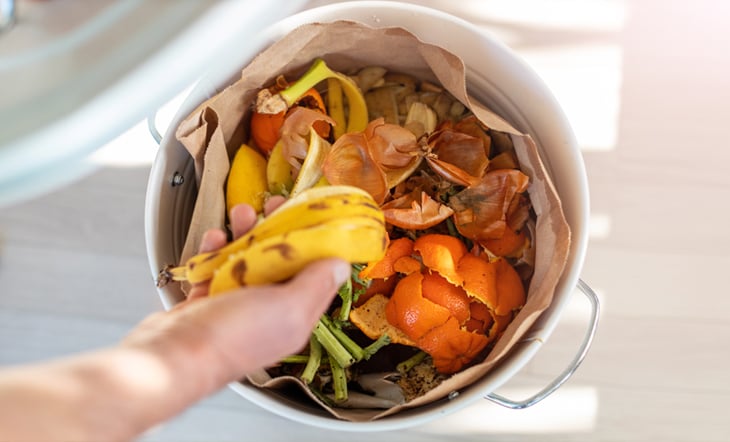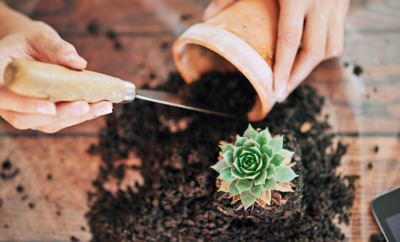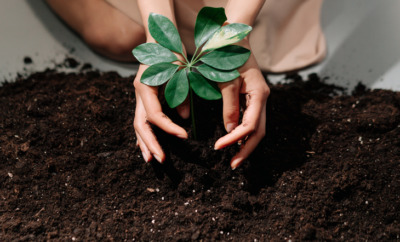Reduce Your Food Waste With This Simple 6-Step Guide to Home Composting

Most of us pay attention to the food we’re putting into our mouths, but what about all those leftover scraps we’re tossing? Enter this beginners guide to home composting – one of the easiest and most sustainable things anyone can do in their kitchen!
Read on for all you need to know about how to make compost at home, regardless of how much (if any) yard space you may have.
Home Composting Is Our Answer to the Problem of Food Waste
The stunning truth is, in America alone we toss an average of 40% of all our food (yes, read that again). And of our total waste produced, food scraps and garden waste makes up a whopping 28% of it.
Even if we’re super mindful about minimizing our food waste as much as possible, there are certain parts like peels, skins and past-their-prime leftovers that inevitably end up chucked.
And all that waste, even the inedible parts, has a large footprint on our environment. It fills up our landfills, it contributes to the billions we spend on waste management, and it produces methane, a harmful greenhouse gas.
Read: 3 Simple Ways We Can All Help Create Healthier Ecosystems
With the information and guidance included in this simple beginners guide to home composting, you’ll be taking a tangible step toward saving some of that food waste by repurposing it into nutrient-rich fertilizer to put back into the land. (Don’t have a garden? More on that below.)
The Vast Benefits of Composting
If it wasn’t already obvious, the benefits of composting at home are numerous. Less waste heads to our landfills, less greenhouse gasses are produced, it saves all of us money, and the end product is something beautiful and beneficial that can be used as a rich, natural fertilizer for plants.
In the US alone, an average of 40% of all food gets wasted or thrown away.
In addition to the above benefits, which are compelling enough to speak for themselves, there is also the benefit of increasing mindfulness around our habits of consumption.
If you’ve been conscious about how to reduce your own carbon footprint, and/or if you are trying to live a low or even zero waste lifestyle, you’ll need to know these composting at home tips.
Here’s Your Step-By-Step Guide to Home Composting:
If you’ve ever felt daunted by how to make compost at home – don’t. It’s simpler, less gross, and requires way less space and know-how than you think.
Let’s dive in.
1. Gather the Scraps
The toughest part of composting at home might be retraining yourself not to toss all those scraps like banana peels, expired lettuce, onion skins, etc in the trash. But you’ll adjust! We suggest getting a chic (yes, really!) countertop compost bin like this one to collect your food scraps.
This step doesn’t have to be fancy. What do you need to make compost, really? A plastic bag or old milk carton works just fine. If you’re worried about a smell or fruit flies, stash your scraps in the freezer until you’re ready to dump them!
An easy composting rule of thumb: anything plant-based goes in the bin.
Avoid trying to compost dairy or meat (like bones, and anything buttery or greasy – which may attract animals.) Eggshells though – and even hair clippings – are fair game!
Other items you can save from the trash and keep for the compost include:
- Pet fur
- Coffee grounds (filters too)
- Nut shells
- Leaves and plant waste
- Tea bags
- Paper

2. If You Have a Yard: Build a Compost Pile for Dumping Your Scraps
Step one of how to make compost at home is incredibly easy, but next we need to figure out what to do with all these lovely scraps.
If you have a yard, even a small one, you can easily choose a corner of your yard as your designated compost pile. It can be as simple as an old garbage can, container made of pallets, chest or bin of any kind. Another option is to make a cylinder with some type of netting like hardware cloth. Again, no need to get fancy!
You’ll want your pile away from heavily trafficked areas of the yard most likely, because it’s not exactly an inviting sight to most, and away from walls in case the compost leaves a stain. You’ll want it within reach of a garden hose because water is an important step (more on that soon.)
You can totally compost on your patio or balcony by the way – a big yard is not a requirement for how to make compost at home.
3. If You Don’t Have a Yard: Find Someone Else to Take Your Scraps
If you don’t have the room or prefer to let someone else deal with the actual composting itself, here are a few great places to check with. With a little Googling, you’ll likely find you have several of these options available to you.
- Check with your local municipality; many cities and towns have composting programs you can opt into
- Speak to whoever runs your local community garden – they’ll often welcome the compost to use as a soil amendment
- Got a neighbor who gardens? They’ll likely be thrilled to take your scraps
- Check out awesome programs like this one, specifically made to connect people with compost scraps with those who want them. Or this one, which will even bring the bin to you and collect the scraps!
4. If You’re Composting at Home: Layer Your Browns and Greens
There can be a lot of pretty technical sounding talk when it comes to how to make compost at home; discussion of things like microorganisms, carbon, nitrogen, drainage, aeration… But in our guide to home composting, we think you can keep it pretty simple – there’s no need to overcomplicate.
In addition to your food and yard scraps – your “greens,” you’ll need to layer in some “browns,” like dried leaves, pine needles, egg cartons or newspapers. They’re a critical component of this process and will be layered in with the greens to allow the magic to happen.
More specifically, these “browns” add a dry layer and help to keep air flowing through the pile. They maintain the proper moisture balance, and ultimately allow the microorganisms responsible for breaking down the scraps – to do their job.
Think of your compost pile as a layer cake.
You’ll want to make the brown layers about two to three times thicker than the green. You’ll also want to start your pile with a brown layer on the bottom, and start layering from there. Don’t stress about perfect proportions – the idea is to keep a good blend of both with, again, more browns than greens.
5. Add Water
The other key component in composting 101 is water! Depending on the “wetness” of your green scraps and other factors like how much it’s raining and if our pile is uncovered or not, you may need to add some water to the mix.
You’re going for roughly “wrung out sponge” wetness – so certainly not bone dry (if it is, give it a good spray with a garden hose), but also not a soggy mess. If it’s too wet, add more browns. You may also need to give the pile an occasional tossing to keep things mixed up and moving, and from turning into a tough mass.
Don’t stress perfecting your pile – it’s a learning experience and you can always adjust your ratios and troubleshoot as you go.

6. “Harvest” and Use Your Compost
Congratulations- you have made it to the fun part!
After you’ve built your pile and layered it up, the process of turning from scraps to usable, rich fertilizer to amend your soil and boost plant health takes anywhere from a few months to a year.
The time to “harvest” depends on the size of your compost pile as well as conditions like the climate you’re in, the mixture, the size of your scraps when you added them, etc.
There are a few ways to “know when your home compost is done” and ready to add back into the soil. It’s all about how it looks and smells! You’ll know it’s done when it’s dark, rich, fluffy, and soil-like in consistency. It will smell earthy and rich – not at all like trash or rotting scraps.
Put Your Food Scraps to Good Use With This Easy Guide to Home Composting
You’ve turned what could have been fated to sit in a landfill into a rich, nutritious addition to add back into our vegetable plot or patio garden or donate to a gardener who can use it.
Feeling inspired to sprinkle some more zero-waste initiatives into your life and home? We’ve got you covered with these 7 Eco-Friendly Home Makeover Tips That Are Cost Effective + Doable
You can also enjoy the process of home composting knowing that you’re living a conscious lifestyle and being good to Mother Earth. A final benefit of composting is the added mindfulness element it introduces to what we consume and the way in which we consume it.
Do you compost at home? Show us your composting garden and share any other easy home composting tips in the comments below – we love hearing from you!


This Month's Letter
From the Editor
Monthly motivation and food for
thought from our founder.




























